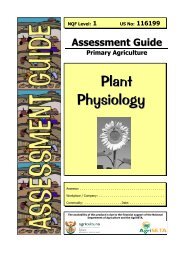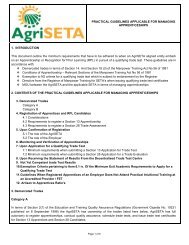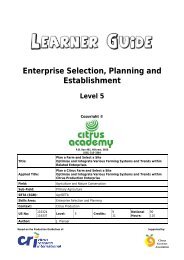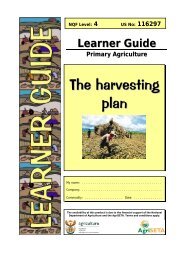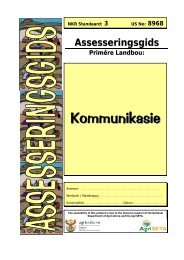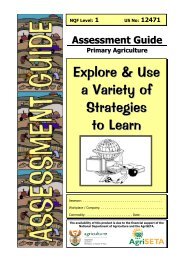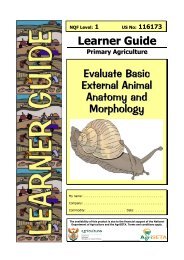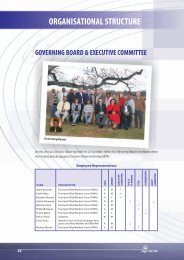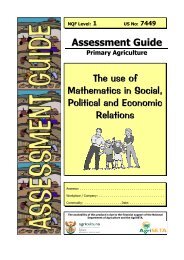Effective communication skills - AgriSETA
Effective communication skills - AgriSETA
Effective communication skills - AgriSETA
You also want an ePaper? Increase the reach of your titles
YUMPU automatically turns print PDFs into web optimized ePapers that Google loves.
NQF Level: 2 US No: 8962<br />
Assessment Guide<br />
Primary Agriculture<br />
<strong>Effective</strong><br />
<strong>communication</strong><br />
<strong>skills</strong><br />
Assessor: . . . . . . . . . . . . . . . . . . . . . . . . . . . . . . . . . . . . . . . . . .<br />
Workplace / Company: . . . . . . . . . . . . . . . . . . . . . . . . . . . . . . . . .<br />
Commodity: . . . . . . . . . . . . . . . . . . . Date: . . . . . . . . . . . . . . . . . .<br />
The availability of this product is due to the financial support of the National<br />
Department of Agriculture and the <strong>AgriSETA</strong>.
Maintain and adapt oral <strong>communication</strong><br />
2<br />
Primary Agriculture NQF Level 2 Unit Standard No: 8962<br />
Before we start…<br />
T<br />
his assessment guide contains all necessary activities<br />
and instructions that will enable the assessor and<br />
learner to gather evidence of the learner’s competence<br />
as required by the unit standard. This guide was<br />
designed to be used by a trained and accredited assessor<br />
whom is registered to assess this specific unit standard<br />
as per the requirements of the <strong>AgriSETA</strong> ETQA.<br />
Prior to the delivery of the program the facilitator and<br />
assessor must familiarise themselves with content of this<br />
guide, as well as the content of the relevant Learner<br />
Workbook.<br />
Please Note:<br />
This Unit Standard<br />
8962 Assessment<br />
Guide must be read<br />
in conjunction with<br />
the generic Assessor<br />
Guide as prescribed<br />
and published by the<br />
<strong>AgriSETA</strong>.<br />
The assessor, facilitator and learner must plan the assessment process together, in<br />
order to offer the learner the maximum support, and the opportunity to reflect<br />
competence.<br />
The policies and procedures that are required during the application of this<br />
assessment are available on the website of the <strong>AgriSETA</strong> and should be strictly<br />
adhered to. The assessor must familiarise him/herself with this document before<br />
proceeding.<br />
This guide provides step-by-step instructions for the assessment process of:<br />
Title:<br />
Maintain and adapt oral <strong>communication</strong><br />
US No: 8962 NQF Level: 2 Credits: 5<br />
This unit standard is one of the building blocks in the qualification listed below.<br />
Please mark the qualification you are currently assessing, because that will be<br />
determined by the context of application:<br />
Title ID Number NQF Level Credits Mark<br />
National Certificate in Animal Production 48976 2 120 <br />
National Certificate in Mixed Farming Systems 48977 2 120 <br />
National Certificate in Plant Production 48975 2 120 <br />
Please mark the learning program you are<br />
enrolled in:<br />
Are you enrolled in a: Y N<br />
Learnership <br />
Skills Program <br />
Short Course <br />
Note to Assessor:<br />
If you are assessing this<br />
module as part of a full<br />
qualification or learnership,<br />
please ensure that you have<br />
familiarized yourself with the<br />
content of the qualification.<br />
Version: 01 Version Date: July 2006
Maintain and adapt oral <strong>communication</strong><br />
3<br />
Primary Agriculture NQF Level 2 Unit Standard No: 8962<br />
1<br />
SO 1<br />
Instructions to learner:<br />
Group activity<br />
Learner Guide: Page 12 Facilitator Guide: Page 12<br />
Class activity for groups:<br />
Learners are divided into groups with four individuals in each group.<br />
A spokesperson is elected to provide feedback on the work done by the group. This<br />
person should be elected on a rotational basis to ensure that each member of the<br />
group has a turn to provide feedback on the work done by the group.<br />
INSTRUCTION:<br />
In the group, with the <strong>communication</strong> model in mind, identify problems or<br />
shortcomings that could be experienced with <strong>communication</strong>. We will call these<br />
problems barriers.<br />
Think of barriers that could impact on the sender, the receiver, the message and the<br />
channel of <strong>communication</strong>. For each barrier that is identified, find a solution to the<br />
situation.<br />
Example: The sender could talk un-clearly of muffled. Solution – ensure that the<br />
message is clear.<br />
Model Answer(s):<br />
The assignment/ discussion aims to assess the effective assimilation of the<br />
<strong>communication</strong>s process in terms of the sender, message and recipient. The effective<br />
identification of barriers impacting on either one of the factors in the model indicates<br />
that the process and impact of all the role-players in the process is accomplished.<br />
The following saves as examples:<br />
Sender:<br />
Receiver:<br />
Unclear message – clarify message<br />
Mixed message – make sure that the message is clear<br />
Coding of message not effectively done for receiver or audience –<br />
understand receiver and send appropriate message<br />
Inability to decode the message effectively – decode or clarify<br />
Communication channel:<br />
Inappropriate channel is selected – use appropriate<br />
channel for the message.<br />
Version: 01 Version Date: July 2006
Maintain and adapt oral <strong>communication</strong><br />
4<br />
Primary Agriculture NQF Level 2 Unit Standard No: 8962<br />
2<br />
SO 2<br />
Instructions to learner:<br />
Class activity<br />
Learner Guide: Page 19 Facilitator Guide: Page 13<br />
1. Identify the three main categories of barriers to <strong>communication</strong> and provide<br />
three examples of barriers falling into each category.<br />
Model Answer(s):<br />
Physical<br />
Any one of the following three<br />
• Poor lighting<br />
• Uncomfortable seating<br />
• Extremes in temperature<br />
• Poor audio-visual aids<br />
Psychological<br />
Any one of the following three<br />
• Personal characteristics including age, gender, appearance or social class<br />
• Background<br />
• Culture<br />
• Language<br />
• Knowledge<br />
• Beliefs<br />
• Values<br />
• Attitudes<br />
• Customs<br />
Cross-Cultural Barriers<br />
Any three of the following:<br />
• Stereotyping.<br />
• Ethnocentricity.<br />
• Language<br />
• Symbols<br />
Version: 01 Version Date: July 2006
Maintain and adapt oral <strong>communication</strong><br />
5<br />
Primary Agriculture NQF Level 2 Unit Standard No: 8962<br />
2. List five barriers to <strong>communication</strong> and explain what can be done to avoid<br />
them.<br />
Model Answer(s):<br />
Any of the barriers <strong>communication</strong> can be indicated and explained. A logical and<br />
practical explanation on how to avoid the barrier can be provided. The idea is to<br />
ensure that the learner has assimilated the information and is able to identify<br />
solutions to address barriers to the <strong>communication</strong> process.<br />
Physical<br />
Any one of the following three<br />
• Poor lighting<br />
• Uncomfortable seating<br />
• Extremes in temperature<br />
• Poor audio-visual aids<br />
Relatively easy to correct as noise can be easily removed or rectified by adjusting<br />
light, ensuring comfortable seating, adjusting temperature, utilising effective audiovisual<br />
aids.<br />
Psychological<br />
• Personal characteristics including age, gender, appearance or social class<br />
• Background<br />
• Culture<br />
• Language<br />
• Knowledge<br />
• Beliefs<br />
• Values<br />
• Attitudes<br />
• Customs<br />
More difficult to rectify and often requires compensation in some instances.<br />
Understanding and knowledge and awareness of own bias, stereotyping and<br />
perceptions are often required to enable rectification. Respect and tolerance with an<br />
open mind-set and willingness to listen, clarify and question in order to achieve<br />
understanding is required.<br />
Cross-Cultural Barriers<br />
• Stereotyping.<br />
• Ethnocentricity.<br />
• Language<br />
• Symbols<br />
Cross-cultural barriers require tolerance and the willingness to learn more of and<br />
accept cultural differences in order to enable <strong>communication</strong>.<br />
Provision in the scope of acceptable answers must also be made for the addressing of<br />
answers relating to the necessity to understand the audience.<br />
Version: 01 Version Date: July 2006
Maintain and adapt oral <strong>communication</strong><br />
6<br />
Primary Agriculture NQF Level 2 Unit Standard No: 8962<br />
3<br />
SO 4<br />
Instructions to learner:<br />
Class activity<br />
Learner Guide: Page 31 Facilitator Guide: Page 15<br />
Prepare a five-minute presentation with a designed one-page handout for<br />
submission to your Facilitator on any of the provided topics.<br />
You will be expected to present the topic to the class. (Audience)<br />
Topics<br />
i. The career I chose<br />
ii.<br />
iii.<br />
iv.<br />
Study for success<br />
My most favourite picture<br />
An then the rain came<br />
v. The impact of global warming on our lives<br />
vi.<br />
Farming – profitable or not<br />
Model Answer(s):<br />
The purpose of the presentation is to enable the learner to actively apply the <strong>communication</strong> process and<br />
prepare <strong>communication</strong> taking into consideration the message, the audience the media of <strong>communication</strong><br />
and to enable feedback to assess the efficiency of the application of the <strong>communication</strong> model.<br />
This is best assessed through a checklist and some oral clarification should it be required.<br />
The following Checklist for assessment is provided:<br />
CHECKLIST – ORAL PRESENTATION<br />
CRITERIA YES NO COMMENTS<br />
AND FEEDBACK<br />
The purpose of the <strong>communication</strong> is<br />
clearly stated<br />
Are the needs of the audience clearly<br />
analysed<br />
Is the format selected suitable<br />
Is the main idea and supporting points<br />
forming an effective topic outline<br />
Version: 01 Version Date: July 2006
Maintain and adapt oral <strong>communication</strong><br />
7<br />
Primary Agriculture NQF Level 2 Unit Standard No: 8962<br />
Is information contained in the<br />
presentation organised in an effective way<br />
supporting coherence<br />
Is the introduction grabbing attention of<br />
the audience<br />
Is the closure an effective summary and<br />
call for action<br />
Unity, coherence and emphasis in the<br />
presentation can clearly be identified.<br />
Are Sources if research was required<br />
clearly provided<br />
Was the provided time frames adhered<br />
to<br />
OVERALL FEEDBACK TO THE LEARNER:<br />
My Notes …<br />
. . . . . . . . . . . . . . . . . . . . . . . . . . . . . . . . . . . . . . . . . . . . . . . . . . . . . . . . . . . . . . . . . . . . . . . . . . . . . . . . . .<br />
. . . . . . . . . . . . . . . . . . . . . . . . . . . . . . . . . . . . . . . . . . . . . . . . . . . . . . . . . . . . . . . . . . . . . . . . . . . . . . . . . .<br />
. . . . . . . . . . . . . . . . . . . . . . . . . . . . . . . . . . . . . . . . . . . . . . . . . . . . . . . . . . . . . . . . . . . . . . . . . . . . . . . . . .<br />
. . . . . . . . . . . . . . . . . . . . . . . . . . . . . . . . . . . . . . . . . . . . . . . . . . . . . . . . . . . . . . . . . . . . . . . . . . . . . . . . . .<br />
. . . . . . . . . . . . . . . . . . . . . . . . . . . . . . . . . . . . . . . . . . . . . . . . . . . . . . . . . . . . . . . . . . . . . . . . . . . . . . . . . .<br />
. . . . . . . . . . . . . . . . . . . . . . . . . . . . . . . . . . . . . . . . . . . . . . . . . . . . . . . . . . . . . . . . . . . . . . . . . . . . . . . . . .<br />
. . . . . . . . . . . . . . . . . . . . . . . . . . . . . . . . . . . . . . . . . . . . . . . . . . . . . . . . . . . . . . . . . . . . . . . . . . . . . . . . . .<br />
. . . . . . . . . . . . . . . . . . . . . . . . . . . . . . . . . . . . . . . . . . . . . . . . . . . . . . . . . . . . . . . . . . . . . . . . . . . . . . . . . .<br />
. . . . . . . . . . . . . . . . . . . . . . . . . . . . . . . . . . . . . . . . . . . . . . . . . . . . . . . . . . . . . . . . . . . . . . . . . . . . . . . . . .<br />
. . . . . . . . . . . . . . . . . . . . . . . . . . . . . . . . . . . . . . . . . . . . . . . . . . . . . . . . . . . . . . . . . . . . . . . . . . . . . . . . . .<br />
. . . . . . . . . . . . . . . . . . . . . . . . . . . . . . . . . . . . . . . . . . . . . . . . . . . . . . . . . . . . . . . . . . . . . . . . . . . . . . . . . .<br />
. . . . . . . . . . . . . . . . . . . . . . . . . . . . . . . . . . . . . . . . . . . . . . . . . . . . . . . . . . . . . . . . . . . . . . . . . . . . . . . . . .<br />
. . . . . . . . . . . . . . . . . . . . . . . . . . . . . . . . . . . . . . . . . . . . . . . . . . . . . . . . . . . . . . . . . . . . . . . . . . . . . . . . . .<br />
. . . . . . . . . . . . . . . . . . . . . . . . . . . . . . . . . . . . . . . . . . . . . . . . . . . . . . . . . . . . . . . . . . . . . . . . . . . . . . . . . .<br />
. . . . . . . . . . . . . . . . . . . . . . . . . . . . . . . . . . . . . . . . . . . . . . . . . . . . . . . . . . . . . . . . . . . . . . . . . . . . . . . . . .<br />
. . . . . . . . . . . . . . . . . . . . . . . . . . . . . . . . . . . . . . . . . . . . . . . . . . . . . . . . . . . . . . . . . . . . . . . . . . . . . . . . . .<br />
. . . . . . . . . . . . . . . . . . . . . . . . . . . . . . . . . . . . . . . . . . . . . . . . . . . . . . . . . . . . . . . . . . . . . . . . . . . . . . . . . .<br />
Version: 01 Version Date: July 2006
Maintain and adapt oral <strong>communication</strong><br />
8<br />
Primary Agriculture NQF Level 2 Unit Standard No: 8962<br />
Summative Test and Attitude &<br />
Attribute Evaluation<br />
B<br />
efore the knowledge test is undertaken, the learner must be reminded of what is<br />
expected from him / her in terms of summative and reflexive competence. Read<br />
and explain to the learner, the Preparation for Your Final Assessment section in<br />
the learner workbook. Learners and assessor should sign off this section to<br />
acknowledge that this step was completed.<br />
Please set up a knowledge test from the questions given as a guideline to learners<br />
and supply each learner with a test sheet.<br />
Supply each report with the following heading:<br />
Unit Standard: 8962 NQF Level: 2<br />
Learner Name:<br />
Questions<br />
Model Answers<br />
Version: 01 Version Date: July 2006
Maintain and adapt oral <strong>communication</strong><br />
9<br />
Primary Agriculture NQF Level 2 Unit Standard No: 8962<br />
1. Explain the <strong>communication</strong><br />
process and the roles of the<br />
received and sender in the<br />
<strong>communication</strong> process.<br />
a) Include a graphic depiction indicating at<br />
minimum the sender, receiver, channel of<br />
<strong>communication</strong> and an indication of the<br />
necessity to encode, decode and provide<br />
feedback. The depiction can effectively utilise<br />
two “persons” instead of the textbox approach<br />
followed in the learning material.<br />
Assessment is thus not aimed at the correct<br />
duplication of learning material content, but<br />
rather a clear indication that the learner<br />
understands the model.<br />
The <strong>communication</strong> process<br />
The <strong>communication</strong> process consist or two<br />
main parties, the sender and the receiver. The<br />
channel of <strong>communication</strong> (method of<br />
<strong>communication</strong>) carries the communicated<br />
message from the sender to the receiver, and<br />
can contain various filters, which can add or<br />
take away certain meanings in the message.<br />
The Sender<br />
The sender initiates the message, with a<br />
specific reason or purpose. The purpose<br />
will influence the encoding of the message in<br />
order to reach the receiver effectively. When a<br />
sender starts to encode the message he wants<br />
to send, he should take into account the<br />
purpose of the <strong>communication</strong>, the situation<br />
the receiver is in and the <strong>communication</strong><br />
channel he intends to use. Failure to do this<br />
almost always means failure to communicate<br />
effectively and efficiently.<br />
The Communication Channel<br />
The <strong>communication</strong> channel is the system that<br />
carries the message. It can be verbal or<br />
written or a combination of the two such as a<br />
presentation.<br />
The Receiver<br />
The receiver is the person for whom the<br />
message is intended and the receiver needs<br />
to decode the message and provide<br />
feedback.<br />
Version: 01 Version Date: July 2006
Maintain and adapt oral <strong>communication</strong><br />
10<br />
Primary Agriculture NQF Level 2 Unit Standard No: 8962<br />
Note: It is required that provision is made for<br />
assimilation of information and the reproduction<br />
thereof in learners own words. The effective<br />
answering of this question entails the correct<br />
identification of the type of barrier and a short<br />
accurate explanation of the identified barriers in the<br />
category.<br />
2. Explain the physical barriers<br />
to <strong>communication</strong>.<br />
Physical barriers include all physical aspects that<br />
prevent us from sending and receiving messages<br />
effectively:<br />
• Noise – additional sounds that may affect the<br />
transfer of the message.<br />
• Poor lighting – removes the ability to “read”<br />
non-verbal <strong>communication</strong> and thus impacts<br />
on the decoding of the message.<br />
• Uncomfortable seating – discomfort can<br />
interfere with effective listening which could<br />
affect effective transfer of the message<br />
• Extremes in temperature – discomfort can<br />
interfere with effective listening and this<br />
could affect the transfer or the message<br />
• Poor audio-visual aids – affects transfer of<br />
the message through distraction and unclear<br />
written <strong>communication</strong><br />
• Delays – such as for voice messages or<br />
electronic mail impacts on the receipt and<br />
feedback in terms of the message.<br />
Version: 01 Version Date: July 2006
Maintain and adapt oral <strong>communication</strong><br />
11<br />
Primary Agriculture NQF Level 2 Unit Standard No: 8962<br />
Note: It is required that provision is made for<br />
assimilation of information and the reproduction<br />
thereof in learners own words. The effective<br />
answering of this question entails the correct<br />
identification of the type of barrier and a short<br />
accurate explanation of the identified barriers in the<br />
category.<br />
3. Explain the Psychological<br />
barriers to <strong>communication</strong>.<br />
The psychological barriers include:<br />
• Personal characteristics – such as age,<br />
sex, appearance and social class; which<br />
affect the interaction between the sender<br />
and receiver.<br />
• Background - of both sender and receiver<br />
affects the ability to encode and decode<br />
messages.<br />
• Culture - the customs, norms, values and<br />
behaviours of a group of similar people, and<br />
can be seen as a way of life.<br />
• Language – affecting the nuances of words<br />
and expressions that have been developed<br />
by that society over the years.<br />
• Knowledge and experience vary from<br />
person to person and depend on culture,<br />
abilities and interest.<br />
• Beliefs - firm opinions about situations,<br />
statements and facts<br />
• Religion - a belief in a higher power as part<br />
of a system of faith and worship.<br />
• Values - principles and standard of<br />
behaviour.<br />
• Attitudes - how we think and feel about<br />
ourselves, the people around us, and the<br />
situation that we find ourselves in.<br />
• Customs - the ways of acting or behaving<br />
that have become established in a particular<br />
society.<br />
• Perception - the way we ‘see’ and interpret<br />
abstractions such as beauty, honesty or<br />
status.<br />
Version: 01 Version Date: July 2006
Maintain and adapt oral <strong>communication</strong><br />
12<br />
Primary Agriculture NQF Level 2 Unit Standard No: 8962<br />
Note: It is required that provision is made for<br />
assimilation of information and the reproduction<br />
thereof in learners own words. The effective<br />
answering of this question entails the correct<br />
identification of the type of barrier and a short<br />
accurate explanation of the identified barriers in the<br />
category.<br />
Cross-cultural <strong>communication</strong> takes place when the<br />
sender and receiver are of different cultures. (Culture<br />
describes the norms, values, beliefs and perceptions<br />
shared by a group of people.)<br />
4. Explain the cross-cultural<br />
barriers to <strong>communication</strong>.<br />
The differences in terms of the above often lead to:<br />
• Stereotyping. - we generalise about a<br />
group, often resulting in racist or sexist<br />
language<br />
• Ethnocentricity. - judging everyone else<br />
according to one’s own norms, beliefs and<br />
values.<br />
• Language - a complex problem in crosscultural<br />
<strong>communication</strong>. Most of us have an<br />
inner picture of what a word or phrase<br />
means, and when that inner picture differs,<br />
there can be a breakdown in <strong>communication</strong>.<br />
• Jargon or slang - specialist words that<br />
relate to a particular profession, which are<br />
not readily understood by a layman - will<br />
impede <strong>communication</strong>.<br />
• Symbols – symbol can mean different<br />
things to different people.<br />
• Different concepts of space and time –<br />
may lead to discomfort and thus impacts on<br />
the message.<br />
• Eye contact, touch and gestures - mean<br />
different things to different cultures. The<br />
important thing is to recognise the<br />
differences and to avoid the assumption that<br />
your way is the only way-to avoid being<br />
ethnocentric.<br />
Version: 01 Version Date: July 2006
Maintain and adapt oral <strong>communication</strong><br />
13<br />
Primary Agriculture NQF Level 2 Unit Standard No: 8962<br />
5. Explain how <strong>communication</strong><br />
planning takes place within<br />
the context of<br />
Determining the audience<br />
Utilising correct vocabulary<br />
Non-verbal <strong>communication</strong><br />
Note: It is required that provision is made for<br />
assimilation of information and the reproduction<br />
thereof in learners own words. The effective<br />
answering of this question entails the correct<br />
identification of the actions required in terms of<br />
addressing the various factors.<br />
The audience<br />
Understanding who the message is intended to will<br />
impact on the planning of the <strong>communication</strong>. The<br />
following information to plan for <strong>communication</strong> is<br />
important in terms of the audience:<br />
How large will the audience be<br />
What age and sex will be represented<br />
What will the audience’s level of education be<br />
What will the level of intelligence be<br />
What is the cultural background<br />
What language does the audience speak<br />
What is their occupation<br />
What is their level of seniority<br />
It is also important to establish the audience’s<br />
potential view of you as the sender, their attitudes to<br />
the message, and the location of the audience when<br />
the message is transferred.<br />
Finally, you need to establish what sort of result you<br />
are looking for, in other words, what action you want<br />
your audience to take after they receive your<br />
message. This will depend on the purpose of your<br />
<strong>communication</strong>. You can analyse the audience<br />
incessantly, but your <strong>communication</strong> will still fail if<br />
you have not decided on the purpose or reason for<br />
communicating – what you want to achieve.<br />
Vocabulary<br />
The words you use to convey your message should<br />
suit the purpose and the audience. The following<br />
guidelines are provided:<br />
Avoid technical terms.<br />
• Choose familiar words that are often used<br />
– the shorter the words, the better.<br />
• Be as specific as possible.<br />
• Watch adjectives and adverbs.<br />
• Choose the right level of formality for<br />
the occasion<br />
• Choosing the right tone and style<br />
Non-verbal <strong>communication</strong><br />
Includes all the non-verbal messages sent by the<br />
sender and receiver of a message.<br />
Posture, facial expressions and clothing all convey a<br />
message through the perception it creates when an<br />
individual decodes visual stimuli. It is continuous and<br />
is often trusted more than the things people say.<br />
Version: 01 Version Date: July 2006
Maintain and adapt oral <strong>communication</strong><br />
14<br />
Primary Agriculture NQF Level 2 Unit Standard No: 8962<br />
Non-verbal messages can be misleading and thus<br />
impacts negatively on the message. Body Language<br />
and personal space is two of the types of non-verbal<br />
<strong>communication</strong> that impacts on oral <strong>communication</strong>.<br />
Note: The learner is expected to identify the<br />
techniques for effective listening and interpret these<br />
in terms of its contribution to the <strong>communication</strong><br />
process. The following serves as a guideline as it is<br />
expected that learners communicate in their own<br />
words from a personal frame of reference:<br />
Proper listening will ensure that the verbal message<br />
is clearly received.<br />
Empathetic listening will assist to remove some<br />
of the barriers to <strong>communication</strong> as it enables<br />
understanding of someone else’s point of view, even<br />
if you don’t agree with it.<br />
6. Explain how good listening<br />
contributes to effective<br />
<strong>communication</strong>.<br />
The avoiding of pre-judging of the contents of the<br />
message assists with the decoding of the message as<br />
you are trying to understand what is being<br />
communicated from the sender’s point of departure.<br />
In order to understand the message it is important<br />
not to provide noise such as interruption – this as<br />
well as critical listening assists in receiving the whole<br />
message in order to not make assumptions; which<br />
will result in incorrect decoding of the message.<br />
Asking of questions enables feedback; which will lead<br />
to clarifying and decoding the message.<br />
The use of positive non-verbal <strong>communication</strong> such<br />
as nodding and eye contact shows respect and<br />
assists in the removing of <strong>communication</strong> barriers.<br />
Version: 01 Version Date: July 2006
Maintain and adapt oral <strong>communication</strong><br />
15<br />
Primary Agriculture NQF Level 2 Unit Standard No: 8962<br />
Note: It is required that provision is made for<br />
assimilation of information and the reproduction<br />
thereof in learners own words. The effective<br />
answering of this question entails the correct<br />
identification of the factors to consider in the<br />
planning and presenting of a presentation.<br />
The following should be included and should be<br />
explained on a basic level:<br />
• The reason for the message<br />
There are many purposes for communicating a<br />
message, some of which include:<br />
• Describing or explaining something<br />
• Recording results<br />
• Rejecting or accepting proposals<br />
• Evaluating alternatives<br />
• Apologising<br />
• Informing<br />
Often some of these purposes will be combined<br />
7. Identify and discuss the<br />
factors to consider in the<br />
planning and presenting of a<br />
presentation.<br />
• Who the audience will be<br />
The following information to plan for<br />
<strong>communication</strong> is vital:<br />
• How large will the audience be<br />
• What age and sex will be represented<br />
• What will the audience’s level of<br />
education be<br />
• What will the level of intelligence be<br />
• What is the cultural background<br />
• What language does the audience<br />
speak<br />
• What is their occupation<br />
• What is their level of seniority<br />
• What message/information needs to be<br />
disseminated<br />
Exactly what is the purpose of the message<br />
and what is the information required to bring<br />
the message across<br />
• How best to transmit the message<br />
What mode of <strong>communication</strong> will work best,<br />
and in a presentation, what is the best type<br />
of audio-visual equipment and presentation<br />
style to use.<br />
8. Discuss the use of questions<br />
to obtain information and<br />
clarify meaning.<br />
Questions assist to decode the message<br />
through the clarification of uncertainties that<br />
the receiver might have. The most important<br />
questions to consider is “Who”, “What”,<br />
“Where”, “when”, “Why” and “How”.<br />
Version: 01 Version Date: July 2006
Maintain and adapt oral <strong>communication</strong><br />
16<br />
Primary Agriculture NQF Level 2 Unit Standard No: 8962<br />
Note: It is required that provision is made for<br />
assimilation of information and the reproduction<br />
thereof in learners own words. The effective<br />
answering of this question entails the correct<br />
identification of the factors and the display of an<br />
understanding of how these factors impact on the<br />
transfer of <strong>communication</strong>.<br />
The following serves as a guideline:<br />
9. Discuss the use of tone,<br />
volume, pitch, and repetition<br />
to ensure the effective<br />
transfer of <strong>communication</strong><br />
during a presentation.<br />
Tone describes the sender’s attitude towards the<br />
receiver and the material being communicated. In a<br />
spoken message it is conveyed by your voice, your<br />
body language and the words you use. In written<br />
messages tone is conveyed by the words you use.<br />
Most of your correspondence should have a friendly<br />
or neutral tone, rather than a stiff or unfriendly tone.<br />
Style refers to a way of writing or speaking. It is the<br />
way a sender puts together words for a wide range<br />
of purposes and audiences. Style can be defined in<br />
terms of how formal it is - personal or impersonal,<br />
active or passive or concise or wordy.<br />
Pitch refers to either the use of the voice – high<br />
pitched or neutral. It can also refer to the level at<br />
which the information provided is pitched – in terms<br />
of analysing the audience and the use of the correct<br />
vocabulary, technical terms and jargon.<br />
Repetition ensures that the main ideas in a<br />
message are repeated thus ensuring that it is clearly<br />
identified as important.<br />
Version: 01 Version Date: July 2006
Maintain and adapt oral <strong>communication</strong><br />
17<br />
Primary Agriculture NQF Level 2 Unit Standard No: 8962<br />
10. Explain why it is important<br />
to accommodate cultural<br />
sensitivities in the<br />
<strong>communication</strong> process.<br />
Note: It is required that provision is made for<br />
assimilation of information and the reproduction<br />
thereof in learners own words. The effective<br />
answering of this question entails the effective<br />
understanding of the reality that culture will always<br />
impact on <strong>communication</strong>. The making of provision<br />
therefore enables planning of <strong>communication</strong> to<br />
increase effectiveness.<br />
The following serves as a guideline:<br />
Cross-cultural <strong>communication</strong> takes place when the<br />
sender and receiver are of different cultures. This in<br />
effect means that the norms, values, beliefs and<br />
perceptions shared by a group of people, even in<br />
sub-groups of the same culture can be different.<br />
It is necessary to be sensitive about this reality in<br />
planning <strong>communication</strong> to ensure that we avoid<br />
barriers to <strong>communication</strong> in order to ensure that a<br />
message is communicated as clearly as possible.<br />
Some of the sensitivities that must be considered<br />
are:<br />
Language is influenced by culture. We learn to<br />
speak the language of the society in which we live,<br />
and at the same time, we learn the nuances of words<br />
and expressions that have been developed by that<br />
society over the years.<br />
Knowledge and experience vary from person to<br />
person and depend on culture, abilities and interest.<br />
Beliefs (firm opinions about situations, statements<br />
and facts), as well as religion (a belief in a higher<br />
power as part of a system of faith and worship) are<br />
part and parcel of culture. Both can influence our<br />
values, attitudes and customs.<br />
Values describe our principles and standard of<br />
behaviour, and therefore the things we believe are<br />
important. Attitudes describe the way we think and<br />
feel about ourselves, the people around us, and the<br />
situation that we find ourselves in.<br />
Customs describe the ways of acting or behaving<br />
that have become established in a particular society,<br />
for example shaking<br />
Stereotyping and the wrong belief that everyone in<br />
a group is the same<br />
Ethnocentricity where we judge everyone else<br />
according to one’s own norms, beliefs and values.<br />
Version: 01 Version Date: July 2006
Maintain and adapt oral <strong>communication</strong><br />
18<br />
Primary Agriculture NQF Level 2 Unit Standard No: 8962<br />
11. Describe how spoken<br />
<strong>communication</strong> is combined<br />
with visual features and<br />
body language to maintain<br />
effective <strong>communication</strong>.<br />
Note: It is required that provision is made for<br />
assimilation of information and the reproduction<br />
thereof in learners own words. The effective<br />
answering of this question entails understanding that<br />
all of the factors combine to form the message within<br />
the <strong>communication</strong> process and that it is not only the<br />
spoken text that is decoded.<br />
The following serves as a guideline:<br />
In a presentation, the speaker addressed the<br />
audience verbally. However, in addition to the verbal<br />
message, the speaker, his expressions, body and<br />
hand movements, clothing and the actual visual<br />
presentation all forms part of the overall message<br />
that is received by the audience.<br />
This is combined to form the total message that is<br />
decoded by the audience receiving the message.<br />
Body language, visual features of the message as<br />
well as the content, style and tone of the message is<br />
thus combined into the overall message that is<br />
decoded by the recipient / audience.<br />
Version: 01 Version Date: July 2006
Maintain and adapt oral <strong>communication</strong><br />
19<br />
Primary Agriculture NQF Level 2 Unit Standard No: 8962<br />
12. Explain how speakers<br />
influence audiences within<br />
the context of presentations<br />
in the use of words,<br />
language symbols and<br />
pictures<br />
Note: It is required that provision is made for<br />
assimilation of information and the reproduction<br />
thereof in learners own words. The effective<br />
answering of this question entails the correct<br />
identification of the ways in which the presentation<br />
and incorporation of all the <strong>communication</strong> factors<br />
have a direct impact on the audience.<br />
Speakers influence the audience through the choice<br />
of vocabulary, symbols and explanations as well as<br />
visual pictures as all of these factors form a united<br />
message that is transferred to the receiver.<br />
The spoken text is planned in terms of the right<br />
vocabulary and words:<br />
• If for example, technical terms are selected<br />
for an audience not familiar with the<br />
terminology used, the message will not be<br />
unclear. If unfamiliar or difficult words are<br />
used, which is inappropriate for the<br />
audience, the message will again not be<br />
understood clearly. It is thus important to<br />
choose familiar words and be as specific as<br />
possible through the avoiding of adjectives<br />
such as very, huge and excellent, as it may<br />
not have the same meaning for all people.<br />
• Language symbols and pictures in a<br />
presentation must also be selected with care<br />
as to not offend or as to ensure that a<br />
shared meaning is in place as to not lead to<br />
misunderstanding. The use of symbols and<br />
pictures can convey and clarify a message<br />
and can add interest to a presentation – but<br />
must be selected and incorporated with care,<br />
Version: 01 Version Date: July 2006
Maintain and adapt oral <strong>communication</strong><br />
20<br />
Primary Agriculture NQF Level 2 Unit Standard No: 8962<br />
Note: It is required that provision is made for<br />
assimilation of information and the reproduction<br />
thereof in learners own words. The effective<br />
answering of this question entails the correct<br />
identification of the factors impacting on the<br />
differences between verbal and written<br />
<strong>communication</strong>. This is not an answer that is readily<br />
available from the learning material and requires the<br />
application of knowledge gained.<br />
13. Identify the main differences<br />
between written and verbal<br />
<strong>communication</strong>.<br />
Written <strong>communication</strong> does not happen when there<br />
is direct visual contact between the sender and<br />
receiver. Writing can structure a message more<br />
carefully but uncertainties cannot be clarified<br />
through questioning – which means that feedback is<br />
not immediate. Non-verbal <strong>communication</strong> as part of<br />
the process is not seen, which could mean that<br />
written messages can be misunderstood.<br />
Verbal <strong>communication</strong> is direct and immediate with<br />
the advantage that spoken <strong>communication</strong> can be<br />
clarified through questioning and is interpreted with<br />
the help of non-verbal cues and decoding of the<br />
message. However, since it is immediate, it is often<br />
not possible to carefully plan the message, which<br />
could also lead to mis<strong>communication</strong> and<br />
misunderstanding if the message is not clear.<br />
14. Demonstrate effective<br />
<strong>communication</strong> through the<br />
preparation and delivery of<br />
a presentation.<br />
The above requires practical assessment of the<br />
application of <strong>communication</strong> factors in the<br />
preparation and provision of a presentation to an<br />
audience. Kindly refer to the provided Checklist.<br />
My Notes …<br />
. . . . . . . . . . . . . . . . . . . . . . . . . . . . . . . . . . . . . . . . . . . . . . . . . . . . . . . . . . . . . . . . . . . . . . . . . . . . . . . . . .<br />
. . . . . . . . . . . . . . . . . . . . . . . . . . . . . . . . . . . . . . . . . . . . . . . . . . . . . . . . . . . . . . . . . . . . . . . . . . . . . . . . . .<br />
. . . . . . . . . . . . . . . . . . . . . . . . . . . . . . . . . . . . . . . . . . . . . . . . . . . . . . . . . . . . . . . . . . . . . . . . . . . . . . . . . .<br />
. . . . . . . . . . . . . . . . . . . . . . . . . . . . . . . . . . . . . . . . . . . . . . . . . . . . . . . . . . . . . . . . . . . . . . . . . . . . . . . . . .<br />
. . . . . . . . . . . . . . . . . . . . . . . . . . . . . . . . . . . . . . . . . . . . . . . . . . . . . . . . . . . . . . . . . . . . . . . . . . . . . . . . . .<br />
. . . . . . . . . . . . . . . . . . . . . . . . . . . . . . . . . . . . . . . . . . . . . . . . . . . . . . . . . . . . . . . . . . . . . . . . . . . . . . . . . .<br />
. . . . . . . . . . . . . . . . . . . . . . . . . . . . . . . . . . . . . . . . . . . . . . . . . . . . . . . . . . . . . . . . . . . . . . . . . . . . . . . . . .<br />
. . . . . . . . . . . . . . . . . . . . . . . . . . . . . . . . . . . . . . . . . . . . . . . . . . . . . . . . . . . . . . . . . . . . . . . . . . . . . . . . . .<br />
. . . . . . . . . . . . . . . . . . . . . . . . . . . . . . . . . . . . . . . . . . . . . . . . . . . . . . . . . . . . . . . . . . . . . . . . . . . . . . . . . .<br />
. . . . . . . . . . . . . . . . . . . . . . . . . . . . . . . . . . . . . . . . . . . . . . . . . . . . . . . . . . . . . . . . . . . . . . . . . . . . . . . . . .<br />
. . . . . . . . . . . . . . . . . . . . . . . . . . . . . . . . . . . . . . . . . . . . . . . . . . . . . . . . . . . . . . . . . . . . . . . . . . . . . . . . . .<br />
Version: 01 Version Date: July 2006
Maintain and adapt oral <strong>communication</strong><br />
21<br />
Primary Agriculture NQF Level 2 Unit Standard No: 8962<br />
Assessment Feedback Form<br />
Comments / Remarks<br />
Feedback to learner on assessment and / or overall recommendations and action plan<br />
for competence:<br />
Feedback from learner to assessor:<br />
Assessment Judgement<br />
You have been found:<br />
Competent<br />
Not yet competent in this unit<br />
standard<br />
Learner’s Signature:<br />
Actions to follow:<br />
Date:<br />
Assessor report to ETQA<br />
Learner results and attendance<br />
certification issued<br />
Assessor’s Signature:<br />
Date:<br />
Moderator’s Signature:<br />
Date:<br />
Version: 01 Version Date: July 2006



